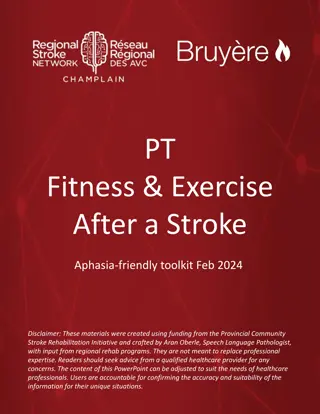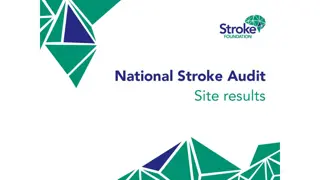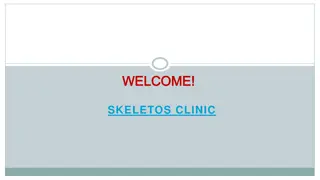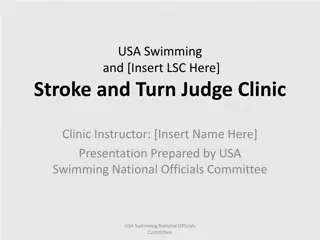Stroke & Turn Clinic
The requirements, uniform, training sessions, and expectations for becoming a certified swim official in the USA Swimming community. Learn about the comprehensive training program and essential protocols involved in officiating competitive swimming meets.
Download Presentation

Please find below an Image/Link to download the presentation.
The content on the website is provided AS IS for your information and personal use only. It may not be sold, licensed, or shared on other websites without obtaining consent from the author.If you encounter any issues during the download, it is possible that the publisher has removed the file from their server.
You are allowed to download the files provided on this website for personal or commercial use, subject to the condition that they are used lawfully. All files are the property of their respective owners.
The content on the website is provided AS IS for your information and personal use only. It may not be sold, licensed, or shared on other websites without obtaining consent from the author.
E N D
Presentation Transcript
Stroke& Turn Clinic
Agenda Welcome and Introductions The Requirements for becoming an Official The Uniform Training Sessions What to Expect At A Meet Protocols/Jurisdiction/Responsibilities Observations and Disqualifications Basic Concepts Mental Traps Definitions Swimmers with Disabilities Conclusion Questions
Welcome and Introductions IntroductionsFacility
TheRequirements What is required to be an official? You must become an Apprentice Official member of USA Swimming. See your Club Administrator for link to register through SWIMS 3.0 Complete the background check required by USA Swimming. https://www.usaswimming.org/background-checks Complete the Athlete Protection Training (APT) required by USA Swimming (no cost involved). https://www.usaswimming.org/utility/landing-pages/safe-sport/apt Complete the designated training program for the Stroke & Turn Judge position. Complete the Concussion Protocol Training Download a copy of the Rulebook from the USA Swimming Website. What is involved in the Stroke & Turn Judge training program? Attend a Certification Clinic. At the clinic all steps to become an official will be explained to you. Complete Online Officials Tests covering Stroke & Turn/Timer on the USA Swimming website. Complete an apprenticeship of six sessions at sanctioned meets working with a certified official to gain knowledge of proper officiating protocol. Have the referee for the session sign off on the training card.
TheUniform White Polo Shirt For AMS Shirts - https://www.teamunify.com/lscamso/UserFiles/File/AMS%20Of ficials%20shirt%20order%20form_updated%20Jan2017(1).pdf For USA Swimming Shirts - http://www.usaswimofficials.com/ Navy Pants/Skirt/Shorts White Shoes Name Tag https://www.hastyawards.com/catalog/Swimming/Name %20Tags/24/86/product/Allegheny%20Mountain%20Swi mming%20Nametag/962/ Hats are permitted at outdoor venues and can contain no club logos
Training Sessions Complete a minimum of 6 training sessions at a sanctioned meet. One session per day is preferred and recommended. Sign up prior to the session on the Official's website. Click on the AMS Officials Meet Sign-Up Report to Referee for the Session with your Training Card Please try to arrive at least 45 minutes prior to the start of the session. Work with assigned Official(s) Ask Questions Move around the deck
What to Expect At A Meet Normal Meet Flow Sign up for sessions Show up about 45 minutes before the start time Sign in with Referee on Sign-In sheet Participate in the Officials Briefing Ask Questions Be in Position at least 5 minutes before the session start time Be back from breaks on time Don t leave until released by a CJ or Referee Check OTS afterwards to ensure sessions are recorded
Protocols/Jurisdiction/Responsibilities Who are the Players and What do they do Referee In Charge of the Meet Starter Provides a Fair Start for all Swimmers Chief Judge (CJ) Extension of the Referee Handles calls from Stroke & Turn for acceptance by the Referee AO Responsible for accurate times for each swim. Stoke Judge (Walking the Sides & Lead/Lag and Turn Judge) Where to Stand/Stepping Up and Back Wrapping on Backstroke at the Start Gutter vs Ledge Flags to Flags or Wall to Wall Stroke Judge and Turn Judge Raise Your Hand/No Call Observe not Inspect
Observations andDisqualifications Observe the swimmers Scan entire area under your jurisdictionequally Relay Takeoff Protocol and Documentation Backstroke StartsProtocol Disqualifications Raised Hand Heat Sheet Documentation Benefit of Doubt to the Swimmer Chief Judge (CJ) DiscussionPoints What did you see What is the rule Position on the deck Make sure you record the Heat and Lane, plus the infraction observed on Heat Sheet. DQ Slip Completion No Call
Basic Concepts Stroke and turn officials should: 1. Study USA Swimming Official Rules book regularly. 2. Uniformly interpret and apply rules. 3. Call violations when seen, but don't guess or anticipate. 4. Be fair and consistent; always give the swimmer the benefit of any doubt. 5. Disregard club affiliation. Work regularly at the job. 1. Officials need practice, just as competitors do. 2. Working regularly builds confidence. 3. Attend training sessions keep up with rule changes and new interpretations. 4. There is no substitute for experience.
Basic Concepts Be professional in your manner. A good official should: 1. Make decisions quickly and decisively. 2. Do NOT use cell phone or eat on deck while working. 3. Do NOT coach the swimmers. 4. Refrain from cheering and control their emotions. 5. Do Not fraternize with swimmers, coaches or spectators during competition. Disregard club affiliation and personal relationships. 6. Do Not display outward signs during race regarding illegality of a competitor except a raised hand. 7. Do Not concentrate on frequent violators to the exclusion of others. 8. Give undivided attention from start to finish. 9. Admit a mistake; if you made a wrong call, the competitor's welfare is more important than your own ego. 10. If uncertain of your role, consult with the Chief Judge or Referee.
Mental Traps 1. Advantage or disadvantage. There is no intent that whether a swimmer gains advantage should be a factor, thus justifying inaction by officials in not calling violations such as missed turns, touches, etc. This type of negative interpretation only leads to "sloppy" officiating. Unfair advantage may be used to explain one reason why an action is an infraction. Still, a violation of the rules should be noted and the competitor disqualified whether an advantage is gained or not. 2. The "Twice Theory." Some judges feel they should wait until an infraction happens more than once before they call it. There is no basis for waiting to see an infraction happen twice and, in fact, it often won't. The official must simply be certain of what they see and make the call as soon as it is observed. If there is any doubt about the violation, then no call should be made! By the same token, stroke and turn officials should not concentrate on one swimmer to see if the suspected infraction is committed again. They should continue to give all the competitors uniform coverage in observing their performance.
Mental Traps 3. We don t disqualify 8 & Unders. People who take this position often rationalize it by saying they don t want to cause mental trauma to a youngster. While this may sound good, it is grounded in some clearly erroneous beliefs: First, it views the judge s role as punitive. This is completely wrong. Rather, a disqualification should be viewed as: a) protecting the other athletes in the competition, and b) educating the athlete who commits the infraction. Second, it assumes that younger swimmers are beginners while older swimmers are experienced and should be held to a stricter standard. Yet, athletes enter the sport at various ages, and some 8 & unders are more experienced than some teenagers who are just entering the sport. In any event, experience is irrelevant. Finally, the idea that disqualifying an 8 & under will traumatize the child s psyche is ludicrous. Youngsters are constantly being corrected during their early, formative years; that s how they learn.
Mental Traps 4. Don t ask me to judge my child." The referee must know that the judge treats everyone in the field the same fairly and equitably all the time. The referee must be confident that a judge will identify an infraction regardless of who the swimmer is. This is probably the ultimate test of the judge s impartiality. To the judge, this is the time to separate themselves from the parental role and accept the responsibility of being a USA Swimming official. 5. Don t Infer (Extrapolate). You can only call what you see, NOT what you infer. For example, when a two-handed simultaneous touch is required, you must actually see the swimmer miss the wall with the hand on the turn, and not assume that the touch was missed because, by the time you looked, only one hand was touching the wall. Or, as a second example, you must actually see the breaststroker take the second arm pull and be past the widest part of that second stroke before the head surfaces, not assume that the swimmer took two pulls to get that far out in the pool when you saw the head surface.
Mental Traps Don t look for reasons to disqualify. If you see the infraction and it is clear, report it, but if you are uncertain, remember that the benefit of any doubt must go to the athlete.
Definitions SELECTED DEFINITIONS (From the USA Swimming Rulebook) ARM that part of the body that extends from the shoulder to the wrist. HORIZONTAL parallel to the surface of the water. ON THE BACK position of the body when the shoulders are at or past vertical towards the back. ON THE BREAST position of the body when the shoulders are at or past vertical towards the breast. PROPULSIVE having power to propel. SCISSOR KICK use of the top of the instep of one foot and the bottom of the other foot in the propulsive part of the kick SIMULTANEOUSLY occurring at the same time TOUCH contact with the end of the course TURN a point where the swimmers reverse or change direction. WALL vertical portion of the pool, contiguous surfaces of the deck and overflow gutter, he front portion of the starting block or platform, or the touchpad at the end of the course
JUDGING SWIMMERS WITH PHYSICAL DISABILITIES 1. In judging the stroke or kick of a swimmer with a physical disability, the referee and stroke & turn judge should follow the general rule that: if a part of the body is absent or cannot be used, it is not judged; if it is used during the stroke or kick, it should be judged in accordance with the USA Swimming Rules and Regulations. Judgments should be made based on the actual rule not on the swimmer s technique. For example, the breaststroke swimmer with one arm or leg shorter than the other, may have a non-symmetrical stroke or kick, but as long as the arm or leg action is simultaneous, it would meet that portion of the rule. No flotation devices should be permitted. 2. Guidelines for judging swimmers with various disabilities are contained in Article 105 of USA Swimming Rules and Regulations. Get familiar with them. You never know when you will need to apply them at a meet.
Conclusion Officiating can be enjoyable. It is not designed to win popularity contests; however, the self satisfaction of having done a good job is very rewarding. Unfortunately, inferior officials rarely recognize their inadequacies, but fellow officials, coaches and swimmers do. All officials must continually reassess their own performances. This can best be done by regularly reviewing the rules and training material and by attending training sessions. The new or inexperienced official often asks, "How long will it take me to become a good stroke and turn judge?" It depends upon the individual, but it won't happen overnight or without effort. Knowing the rules and attending training sessions are very important, but experience gained by working at meets is the only real teacher. Only experience can build the confidence the stroke and turn judge requires before his or her performance becomes "automatic." Even then, a continuing review of the rules and regular attendance at retraining sessions are essential.
Questions andPractice What s next/how to proceed with training Practice Here and Today At Swim Practices Observe the Swimmers Ask your coach if you can observe practice At Meets Work as many sessions you can once you become an official, repetition and practice enhances your skills. Review the Rule Book prior to eachSession After Training Officials Committee Review and Approval to Proceed Minimum Requirements as S&T to Maintain Certification Progressions to Next Level Officials National Certification Program Questions
ONE MORE ITEM.. How do I sign up? AMS Officials Website AMS Officials Meet Sign-Up Tab On the excel spreadsheet tab, find the meet and enter at the bottom the training sessions you are to attend. Please make sure that you note the number of sessions you have trained so the referee is aware of your training prior to the meet. Once you are certified you would complete the top portion of the spreadsheet for the sessions you are working. How many Sessions do I have to Train? As many as you feel until you are ready to be certified. This is your comfort level, but 6 are required, Should I work meets my team is not attending? YES! Should I work meets that only my swimmer is swimming? NO! Should I not sign up early or just show up at the meet? YES AND NO !!!! PLEASE CHECK THE SIGN-UP SHEET AND CHECK YOUR EMAILS FOR REQUESTS FOR OFFICIALS AT MEETS. IF THERE ARE NOT ENOUGH OFFICIALS, THEN TRAINING OF THOSE SIGNED UP MAY NOT HAPPEN.























